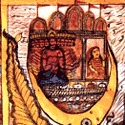
Saris/Unstitched Garments, Textiles, Weaving, Spinning, Khadi
Cotton Jamdani Weaving of Uttar Pradesh
Jamdani here refers to the figured, cotton, flowered weaves of the Gangetic plain (it is also used in reference with the woollen weaves of Kashmir). Jamdanis are very finely textured muslins with dominantly floral (sometimes animal or bird) motifs woven in discontinuous supplementary-weft cotton (occasionally silk or synthetic). The finest of these fabrics is woven in two or more tones of white yarn of varying thickness, used to create effects of light and shade, transparency and opaqueness. The supplementary threads are usually thicker and heavier than the ground – subtle tones and nuances are the hallmark of this sari.
THE TANDA JAMDANI
The main centres of Jamdani weaving in Uttar Pradesh are Tanda (Fyzabad district) and Banaras. In Tanda, ‘finely patterned white jamdanis, usually completely covered with white and foliate patterns, have been created since at least the nineteenth century’ (Lynton: p. 47). ‘Always white on white, the patterning is woven in thicker threads than the ground’, producing ‘an opaque design against a transparent cloth’. The warp is unbleached gray yarn and the motifs are woven with bleached white yarn. (Gold thread is used along with bleached and unbleached white threads in Banaras.)
Tanda cloths are extremely delicate and only white yarn is used for the weaving. In Tanda, fine court bleached white yarn is used for ornamentation. The distinction between the background cloth and the ornaments or motifs is not accentuated. The threads forming the ornamentation or motifs are not cut at the edges, but are left dangling in the spool and then introduced into the figured pick. The figures, therefore, do not fray at the edges.
|
TECHNIQUE & EQUIPMENT
Traditional pit-looms are still used for weaving Jamdani. There is no need for special attachments. The spindle is known as rach and is made out of small bamboo or maize stalks. The number of bamboo splits required depends on the number of floral motifs woven across the width of the cloth.
The kind of weaving done is that two threads of yarn of the same count as the background are used to weave the floral motifs which is done by means of extra spools, the threads of which are passed under and over the ornaments as many times as are required to form the design. The weaver lifts the threads selected with his/her fingers. The kind of weaving done is known as twill-tapestry, which is the same as embroidery where the bamboo-spindle takes the place of the needle. Jamdanis are used for angarkhis, caps and saris.
MOTIFS
The flower motifs which ornament the cloth are woven either vertically a horizontally. The motifs of flowers used for the weaving are chameli, mogra, juhi, khas pomera, genda, khas kamana, ishqapench, harsingar, and phulbanjari.
Some of the typical motifs found in the Jamdani weaving of Uttar Pradesh are:
- Aribel: Bel-creeper or climber running figures arranged diagonally.
- Marava: Straight or wave-like vertical lines with little flower-like motifs.
- Kharibel: Running figures arranged horizontally.
- Kangura: Border design of three-inch width for saris, duppattas and blouses.
- Aribel bhanjvara: Big flowers, two inches apart
- Saro: Vertical pillars or stylised trees with two-and-a-half-inch intervals.
- Katar: Crossed sword with shield motif with half-inch interval.
- Lahar: Wave design arranged horizontally.
- Haravver: Running figures found in vertical lines.
- Patri: Running figures in horizontal lines.
- Jaldar: Ornamental figures arranged in the form of a net.
- Purmatan: Small intricate hexagonal figures with flower designs.
- Jal guldasta: Rose and leaf design alternating with ornamental network.
- Phuldar: Flower-like motifs on the body of the sari.
Pankala: Ornate cones, about three-inch squares, with ornamental motifs inside the cone. - Butla: Ornamental single motifs within the body of the cloth.
- Fardi buta: Small dots arranged close together.
- Masur buta: Ornamental motifs the size of massur dal.
- Makki buta: Small dots the size of a fly.
- Shahi buta: Design made by the use of one kili or shirki or a small spindle.
- Phul ananas: Pineapple motifs.
- Jamiwar: Intricate all-over design.
- Isquapench: Pattern of fine leaves arranged in creeper form.
Gallery
YOUR VIEWS
PRACTITIONERS: INDIA
Access 70,000+ practitioners in 2500+ crafts across India.
BIBLIOGRAPHY
10,000+ listings on arts, crafts, design, heritage, culture etc.
GLOSSARY
Rich and often unfamiliar vocabulary of crafts and textiles.
SHOP at India InCH
Needs to be written.





